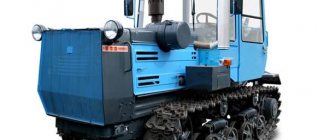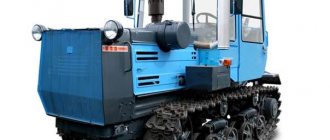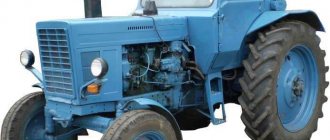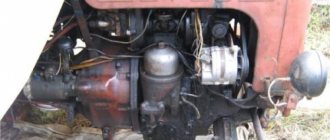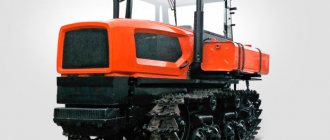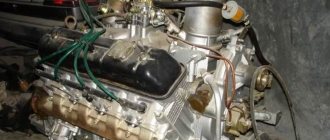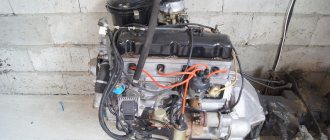Category: ENGINE
- History of the D-245 engine
- Technical characteristics of the D-245 motor
- Motor modifications
- D-245 engine components Core and chamber head
- Crank mechanism
- Nutrition
- Reducing temperature and friction of the D-245 engine
The engine plant, located in Minsk, has produced more than one model of power plants during its existence, among which the D-245 engine has become widespread. The enterprise itself is known far beyond the borders of Belarus, since diesel units meet quality and reliability standards. In the CIS, the plant occupies a leading position in the design of diesel engines for combines, trucks and tractors.
Initially, the D-240 engine, used on the MTZ-80 (82) self-propelled units, was considered the leader in the field. The growing need for larger power units forced designers to develop a new product, which first appeared in 1984. Due to increased acceleration and power, versatility and survivability, diesel quickly became popular among consumers. The engine “got used to the role” and is therefore still produced today.
Installation "D-245. 12C" (ZIL-130):
Total information
To equip buses and trucks with a gross weight of up to 8000 kg, a version of the D-240 engine, equipped with a turbocharger, was created. The new power unit received the designation D-245. Structurally, it is a conventional in-line four-cylinder engine with vertically arranged cylinders. For turbodiesels, a different camshaft design is used, which has five bearings instead of three. A fuel pump with modified fuel injection parameters is also used. The order of the working strokes of the D-245 engine cylinders remained unchanged - first-third-fourth-second. The photo shows a front view of one of the engine options.
With the previous working volume of 4.75 liters, the technical characteristics of the D-245 are at a higher level. The engine has higher power parameters (up to 163 horsepower) and torque (up to 595 N/m) with lower fuel consumption. The weight of an engine not filled with oil and working fluids reaches 560 kg with an overall length of just over a meter. The engine width is 702 mm, and the height from the bottom of the sump to the valve cover is 1080 mm. The D-245 is started only from an electric starter.
History of development
Initially, the D 245 series engine was made in the 7E2 modification, which had increased dimensions and a weight of about 700 kilograms.
This power unit was actually an upgraded version of the outdated 240 series. It complied with the Euro 2 environmental standard and was completely discontinued in the mid-nineties.
In the mid-nineties, the D 245 engine underwent significant changes. The power system was completely changed, direct injectors appeared, and the engine itself began to comply with Euro 3 environmental standards.
This power unit is characterized by its simplicity of design and excellent reliability. The engine weight was significantly reduced, which was 455 kilograms.
Modifications
Depending on the type of car, engines can be equipped with a radiator for intermediate cooling of the air supplied to the cylinders. Depending on the presence of a radiator, turbochargers of various designs are installed on engines. Main engine options:
- 117-horsepower D-245.7, with air cooler;
- 130-horsepower D-245.9, with air cooling;
- 150-horsepower D-245.30, with air cooler;
- 176-horsepower D-245.35, with a radiator for air cooling;
- 105-horsepower D-245.12S, without air cooling radiator.
D-245.35E4 (MAZ) type 2
Diesels D-245, even at the Euro-1 and Euro-2 levels, had to be seriously adapted for installation on cars.
The cylinder block has been modernized for different mountings, and while tractor engines have three camshaft supports, the supercharged car version has five. They have different camshafts, cylinder heads and oil pans: the tractor one has a steel one, while the automobile one has a better noise-absorbing aluminum one, which gives the block additional rigidity. Diesels D-245, even at the Euro-1 and Euro-2 levels, had to be seriously adapted for installation on cars. The cylinder block has been modernized for different mountings, and while tractor engines have three camshaft supports, the supercharged car version has five. They have different camshafts, cylinder heads and oil pans: the tractor one has a steel one, while the automobile one has a better noise-absorbing aluminum one, which gives the block additional rigidity.
First of all, the most popular four-cylinder D-245 is being prepared for the Euro-5 level, but at the same time the “six” D-260 will also be brought up to speed. For modernization, Minsk residents use equipment purchased from the Austrian engineering company AVL. There are many innovations: a Czech turbocharger, an intercooler, common rail fuel equipment made by Bosch (injection pressure 1800 bar) and new Bosch injectors with changed hole angles; a new ramp was installed, a new control unit appeared.
The gearbox that increases the fuel injection pump speed has been eliminated. The timing system uses stiffer valve springs, a camshaft with new valve timing, and the timing gears are quieter - with a changed tooth angle. The combustion chamber has been optimized, new piston rings have been used and the grooves for them have been changed - these measures will prevent the rings from sticking and should reduce oil consumption due to waste.
Block and cylinder head
The main part of the engine is the cylinder block with liners installed in it. The outer surface of the liners is directly washed by the coolant. To avoid leaks, the sleeves have sealing rings. The front and rear walls of the block and three internal jumpers are used to install the crankshaft supports. The bottom covers of these supports are machined together with the mating part, therefore they are non-interchangeable.
There is a special channel inside the block that serves to supply oil under pressure to lubricate the most loaded components. Nozzles are mounted in the even-numbered crankshaft supports to supply oil to the pistons. This procedure reduces the operating temperature of the pistons and increases the durability of the D-245 engine as a whole. Side view of a diesel engine.
The cylinder head is cast iron, equipped with eight valve guides and four holes for fuel injection nozzles. In addition, the head has push-in seats and mounting points for the valve rocker arms. On the sides the head has channels from the intake and exhaust valves. Manifolds for supplying air and removing exhaust gases are installed on these channels. Inside the head there are passages for coolant that coincide with the corresponding channels in the cylinder block. There is a sealing gasket between the head and the block.
Specifications
Technical characteristics of the motor D 245:
| OPTIONS | MEANING |
| Engine weight, kg | 455 |
| Cylinder block material | cast iron |
| Supply system | direct fuel injection |
| Type | in-line |
| Working volume | 4.75 |
| Power | 122 horsepower at 2400 rpm |
| Number of cylinders | 4 |
| Number of valves per cylinder | 2 |
| Piston stroke, mm | 125 |
| Cylinder diameter, mm | 110 |
| Compression ratio | 42386 |
| Torque, Nm/rpm | 420/1400 |
| Environmental standards | EURO 3 |
| Fuel | diesel |
| Fuel consumption | 17 l/100 km combined cycle |
| Oil | SAE 10W-40 and higher |
| How much oil is in the engine | 10.7 |
| When replacing, pour | 10 liters |
| Oil change carried out, km | 25 thousand |
| Engine life, thousand km - in practice | 500+ |
The engine is installed on GAZ-3309, GAZ-33086, GAZ-33081, PAZ buses, medium-tonnage ZIL and MAZ trucks.
Crank mechanism
The D-245 engine is equipped with a steel crankshaft mounted on five supports. The shaft is secured against axial displacements by special half-rings installed in a groove near the rear shaft support. For greater uniformity of operation, additional counterweights are installed on the crankshaft. At the rear end of the shaft there is a cast iron flywheel with a toothed ring for starting the engine.
The engine pistons are similar to parts from the D-240 and contain a combustion chamber. The remaining parts of the crank mechanism are also similar to a conventional tractor engine. Rear view of the clutch housing.
To drive the valves, a scheme with a lower camshaft is used. The force on the valves is transmitted by pushers and rocker arms. The camshaft rotates from the main engine shaft using a gear mechanism. There are marks on the gears that serve to correctly adjust the valve opening phases of the D-245 engine.
History of the D-245 engine
The year 1963 marked the beginning of the development of the motor industry in Minsk, when the creation of engines was established on the basis of the tractor workshop (MTZ). Initially, the goods were intended for domestic, agricultural use. As demand grew, the products were standardized and placed on trucks and harvesting equipment.
The first universal unit was the D-245, which replaced the D-240 in 1984. Operation with self-propelled units gave rise to modifications: the D245 2S2, (S2) engine, etc. And already in 1992, production of the D-245.1 variety began, intended for trucks such as the GAZ-3308 (081, 09) and others.
Structurally, the base is a row product with four chambers arranged vertically. The distribution shaft has five, not three, bearings, the pump supplies fuel using a different type of settings, this is the difference between the D 240 and D 245 engines. Otherwise, the indicators remained unchanged: the volume of the chambers is 4750 cm3, the operating order is “1342”. Together with fuel efficiency, the engine produces up to 164 horses and shows an impulse of 595 Nm. The unit weighs 560 kg, the engine is activated by a 12V electric starter.
Due to its popularity, reliable and durable performance, the engine was continued and today is produced in seven modifications. The 2016 version was adjusted to Euro-5 environmental standards, which made it possible to sell the product to European countries.
Nutrition
The main components of the fuel mixture supply system are the fuel pump, turbocharger and air filter. Depending on the engine model, different pumps are used, differing in fuel injection parameters. The pump is driven by camshaft gears. Optionally, a valve can be installed on the pump to serve as an emergency stop for the D-245 engine. Technically, the valve is an electromagnet with an operating voltage of 12 or 24 Volts with a rod that closes the cross-section of the fuel line. Before being supplied to the pump, the fuel goes through two stages of preparation in coarse and fine filters. The photo clearly shows the fuel pump and fuel cleaning system.
Increased technical characteristics of the D-245 are ensured by the supply of compressed air in a turbocharger. Structurally, it is a centripetal turbine driven by the flow of engine exhaust gases. The impeller of a single-stage compressor is installed on the same shaft with the turbine. The entire mechanism is housed in a compact housing and mounted on the exhaust manifold. On engines with an air cooler, it is possible to adjust the compressor operating parameters. To change the parameters, part of the exhaust gases is allowed to bypass the impeller, which reduces its rotation speed and reduces the boost pressure. The photo shows the location of the turbocharger on the engine.
How does the engine work?
To increase the technical and economic performance of the D-245 diesel engine, its intake system is equipped with a turbocharger, where intermediate cooling of the air occurs. Installing a turbocharger made it possible to regulate the boost power. This significantly increased torque at lower speeds. The presence of a turbocharger ensured that the engine complies with modern environmental standards.
The installation of glow plugs made it possible to start the engine at low air temperatures. The presence of a liquid-oil heat exchanger allows you to quickly achieve the optimal oil temperature.
Engine lubrication system D-245
Engine block
The cylinder block is the main body part of the engine. It is a rigid cast iron casting. The design of the installation contains four removable sleeves. Coolant circulates between its walls and cylinders.
Diesel D-245 body parts
Other structural elements were also installed:
- bosses with covers for five bearings;
- oil channel;
- injectors.
The outer surface of the D-245 block is prepared in a special way for the installation of other elements - oil filter, distribution panel, fuel filters, etc.
Engine crank mechanism
Crank mechanism D-245
There are four connecting rod journals and five main ones on the steel crankshaft. Their design has special cavities that allow additional centrifugal installation of oil. They are covered with threaded plugs.
The axial reinforcement of the crankshaft is provided by four bimetallic half-rings. They are installed in the bores of the cylinder block and in the main bearing cover. To compensate for the loads produced, there are counterweights on several cheeks. This structural element D-245 is additionally equipped with cuffs that perform a sealing function.
Gas distribution mechanism
This mechanism of the D-245 engine contains the following structural elements:
Gas distribution mechanism D-245
- camshaft;
- valves;
- pushers and rocker arms;
- adjusting screws;
- rods;
- springs, axles and rocker arms.
The D-245 camshaft is five-bearing and is driven by the crankshaft. The bearing properties in it are performed by five bushings. Rocker arms, pushers and rods are made of high-quality steel, valves are made of heat-resistant types.
Pump
A block design fuel pump was installed on the D-245 engine. It is equipped with a cam drive and a spool valve dosing unit. The pump is driven from the crankshaft with the inclusion of a distribution gear in the process.
Fuel injection pump MTZ D-245
Lubrication and cooling
To cool the engine, forced circulation of liquid is used through channels inside the block and head. To create pressure, a centrifugal pump located on the front of the engine is used. The pump is driven by a belt drive from the crankshaft. The same belt is used to rotate the generator mounted on the side of the crankcase. The cooling system has a thermostat that allows you to maintain the optimal engine temperature. The thermostat has a place to install a sensor that signals if the motor is overheating.
The D-245 is lubricated by a pump that takes oil from the engine sump. Highly loaded and critical engine components are lubricated under pressure, the rest - with splashes and drops of oil. Oil purification is carried out using a filter with a replaceable paper element. On the D-245 engine, you need to extremely carefully monitor the level and condition of the oil, since the duration of the turbocharger operation depends on these factors.
Advantages
The main advantage of the D-245 is its simplicity and reliability during long-term operation. At the same time, the power plant satisfies all the needs of users, because for many of them it is very important to purchase not only an engine with a long service life, but also with the necessary power parameters.
Engine D-245
DIESEL TRACTORS MTZ-100, MTZ-102
GENERAL DEVICE OF DIESEL D-245 AND D-245L
The MTZ-100 and MTZ-102 tractors are equipped with a four-cylinder in-line four-stroke diesel engine D-245 with direct fuel injection, liquid cooling and turbocharging. Its rated power is 77.2 kW (105 hp) at a crankshaft speed of 2200 rpm. The general view of D-245 is shown in Figures 1 and 2, and D-245L is shown in Figures 3 and 4, their longitudinal and transverse sections are shown in Figures 4 and 7-
The difference between the D-245 and D-245L is the starting system: in the first, from an electric starter, in the second, from a starting carburetor engine.
Diesel D-245 was created on the basis of D-240. An increase in its rated power to 77.2 kW was achieved through the use of turbocharging.
The level of unification with the D-240 diesel engine is more than 74%, and taking into account the use of parts on the D-240 diesel engine from the D-245 diesel engine (reverse unification), its value increases to 86.4%.
In connection with the installation of the TKR-7S-4 turbocharger, such parts of the D-240 diesel engine as the exhaust pipe, exhaust manifold, air filter, etc. were completely changed. To ensure high operational reliability, the piston, crankshaft, set of piston rings, main and connecting rod bearings were modernized , cylinder block and head, valve drive mechanism, fuel pump and filter, water pump drive, etc. A generator with a power of 0.7 kW (instead of 0.4 kW) was used, which ensured the balance of electricity on the tractor.
A diesel engine consists of a cylinder block, a crank mechanism, a gas distribution mechanism, a lubrication system, systems: fuel and air supply, cooling, starting, electrical equipment and turbocharging.
The cylinder block of the D-245 diesel engine has nozzles that supply oil to the bottom of the pistons to ensure their optimal temperature conditions, additional channels for removing gases from the crankcase to the breather, changes have been introduced into the design of the block related to the removal of oil from the turbocharger. Higher quality material was used for the crankshaft and connecting rods. The main and connecting rod bearings are three-layer, made of AO-6 alloy with a running-in coating.
The fastening of the flywheel to the crankshaft has been strengthened with seven bolts instead of six on the D-240 diesel engine. The crankshaft flange has a bore to install one of the clutch shaft supports. The cylinder head is equipped with insertable valve seats (Fig. 5), made of a wear-resistant alloy. The rocker arm shaft supports are installed on two supports with an additional fastening bolt, the lubricant supply to the valve rocker arms has been changed, and the intake and exhaust valves have been sealed. A modernized four-section high-pressure pump type 4UTNM with an anti-smoke pneumatic corrector, as well as an easily removable fine fuel filter element, are used.
Power, torque and fuel consumption vary depending on atmospheric conditions, which are characterized by temperature, humidity, barometric air pressure. Normal operating conditions are considered to be: ambient temperature plus 20°C, barometric pressure 101.3 kPa (760 mm Hg), relative air humidity 50%, fuel density at ambient temperature plus 20°C - 0.83 t/ m3, and its temperature is plus 20°C.
Rice. I. Diesel D-245 (left view);
Rice. 2. Diesel D-245 (fork on the right): 1 — oil dipstick; 2 — oil filler neck; 3 - clamp; 4 — filter with fuel purification pipe; 5 — exhaust manifold; 6 — turbocharger; 7 — thermostat housing; 8 — centrifugal oil filter; 9 - generator.
Rice. 3. Diesel D-245L
Rice. 4. Diesel D-245L (longitudinal section): 1 — oil sump; 2 - oil pump; 3 — crankshaft pulley; 4 — fan belt; 5 — timing gear cover; b - fan; 7 - water pump; 8 — thermostat housing; 9 — piston pin; 10 — connecting rod; 11 - piston; 12— cylinder liner; 13 — cap; 14 — cylinder head cover; 15 — cylinder head; 16 — cylinder head gasket; 17— cylinder block; 18 — back sheet; 19— flywheel; 20— counterweight; 21 - crankshaft; 22 — oil receiver; 23 — piston cooling nozzle; 24 — main bearings; 25 — connecting rod bearings; 26 — cavity in the connecting rod cheek; 27 — distribution gear; 28 — pump drive gear; 29 — flywheel ring gear; 30 — connecting rod bushing; 31 — flywheel mounting bolt.
content .. 1 2 3 7 ..
Piston
MMZ automobile diesel engines are equipped with pistons with an antifriction polymer coating - Czech Almet or Kostroma-based Motordetal.
The cylinder liners are also Czech. MMZ automobile diesel engines are equipped with pistons with an antifriction polymer coating - Czech Almet or Kostroma-based Motordetal. The cylinder liners are also Czech.
Probably, with this approach, Minsk will be able to overcome Euro-6 for D-245. True, in this case, the “ecological” linkage will be much more expensive than the engine itself.
The main question is: when?
Until the Russian government introduces Euro-5 standards, no one will either produce such engines or buy cars with them. And when the corresponding decree appears, the factories will be harnessed to a new burden... and the cars will become more expensive again: engines of the Euro-5 level a priori cannot be cheaper than the versions for Euro-4 and Euro-3. The final price will depend on the manufacturers of neutralization components, and they are all foreign.
Photo: MMZ
A class higher: how Minsk turbodiesels are modernized

